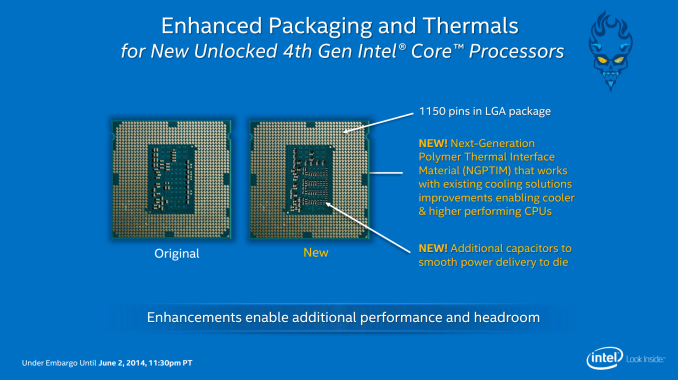Devil’s Canyon Review: Intel Core i7-4790K and i5-4690K
by Ian Cutress on July 11, 2014 10:00 AM EST- Posted in
- CPUs
- Intel
- Haswell
- i7
- Overclocking
- Devil's Canyon
- i5
- 4790K
- 4690K
Conclusions
End-users with CPU intensive workloads always feel justified in requesting for more performance. The only question is if that performance is required at the expense of power, and if the CPU company feel satisfied they can offer a higher performance component with absolute stability. Over the past three generations, Intel CPUs at equal frequency have offered a 5-10% performance boost over the previous generation, usually around the same power envelope. Because 2014 would seem to be a year where there is no major generation change for the mainstream market segment, in order to provide that 10% boost, they have had to go directly at clock speeds.
With the clock speed change, the package is also adjusted in two distinct ways. The first is to add extra decoupling capacitors on the PCB, allowing the voltage regulator on the die to deliver cleaner power to where it needs to go. The second addresses the issue of temperature, whereby the heat generated by the processor is removed. By adjusting the thermal interface material, Intel hopes to have a CPU that is ~10C cooler than the original Haswell CPUs at the same frequency and voltage. This latter part is directly observable, and even when overclocked, the ~10C temperature difference is very much visible.
This leads on to overclocking, the supposed reason for the release of Devil’s Canyon. Lisa Graff, VP and GM of Intel’s Desktop Client Platform Group, indicated in a press call before Computex that the lead design teams on Devil’s Canyon had six months to make the changes, and that the CPUs were aimed at addressing concerns levied at Intel from users who enjoy overclocking. The main concerns were the variability of the headroom of the Haswell CPU line, where some CPUs could only manage +5% whereas others gave +20% extra frequency, along with high temperatures at low clock speeds. By releasing the i7-4790K at 4.0 GHz/4.4 GHz Turbo, this ensures that the out-of-the-box i7-4790K has a better performance than the lowest performing overclocked i7-4770K CPUs. The adjustment in the thermal interface material (which we suspect is a change in the ceramic filler to an aluminum oxide or derivative therein) also gives more headroom for the i7-4790K CPUs that might have been temperature limited otherwise.
For our overclocking performance, both of our CPUs were hitting their voltage limitations as a result of the temperature adjustment. At the top end of our final overclocks, in order to adjust +100 MHz to be fully stable required a large jump of +0.100 volts, pushing the CPU voltage outside of the recommended window for a 24/7 stable Haswell-based processor. Both the i7-4790K and the i5-4690K in our testing gave 4.7 GHz benchmark stable, 100 MHz more than our first i7-4770K sample and 500 MHz more than our second i7-4770K sample.
This ends up being the main selling point for the overclocking end-user: if you own a relatively mediocre Sandy Bridge, Ivy Bridge or Haswell CPU, and have CPU limited throughput, there can be performance gains by investing into the Devil’s Canyon (CPU + Z97 motherboard or Z87 with BIOS updates) ecosystem. These are ‘enhancements’ that Intel should build on for the future, and never remove. I am sure that many enthusiasts would like to see a return to soldering the IHS on, or a single version with this feature.
For users relying on an Ivy Bridge stock system, the i7 Devil’s Canyon can offer a 17% increase over the i7-3770K for CPU benchmarks. For those that need the fastest single-thread VT-d enabled processor according to Intel's specification pages, the i7-4790K also affords that opportunity.
Users that are looking for the fastest GPU for gaming, at 1080p, might not be impressed by either the i5 or i7 Devil’s Canyon. At least in our testing, we saw no improvement from Ivy Bridge to Devil’s Canyon. One might argue that the story would be different for online gaming, or at larger resolutions, however for the latter there is more emphasis on upgrading the GPU over the CPU. While some hardware setups offer this mainstream CPU with three and four-way GPU gaming, typically we end up recommending the extreme platform due to fewer PCIe switches required.
The next question is oriented towards the future. Will the next generation of Intel CPUs perform better than Devil’s Canyon? The expected release date of Broadwell CPUs is still unknown, as is the extent of Intel's desktop offerings. Some media are expecting Broadwell to be more IGP focused as a platform, given the initial expectations of no desktop parts. To put this into perspective: if Broadwell offers a 5-10% IPC increase, Intel has to offer a 4.0 GHz / 4.4 GHz Turbo version in order to make their fastest mainstream processor even faster. However, given the history of Intel’s releases, if they release a top end i7, it will most likely be a 3.6 GHz / 4.0 GHz Turbo part, and offer the same performance as Devil’s Canyon. We cannot predict the overclocking potential, or if Intel is going to migrate the ‘enhanced overclocking features’ of Devil’s Canyon to the new parts. If this is the case, Intel will have to offer a new 'feature' to help sell the new high end parts.
The user has to hedge their bets – when is Broadwell coming to market, and is there going to be a large OC version of Broadwell, the equivalent of Devil’s Canyon is to Haswell? We are currently looking at 5 months away from Broadwell-Y (also known as Core-M) based on Intel announcements but no indication yet when Broadwell-DT is released, meaning an investment in Devil’s Canyon gives the top class mainstream processor based system until then.
The next piece of the puzzle is Haswell-E where many sources, such as CPU-World, are quoting that the low end SKU (an i7-5820K going by previous naming schemes) will be a six-core 3.3 GHz CPU with some amount of turbo. Historically Intel has charged roughly the same amount for the lowest Enthusiast CPU and the top Mainstream CPU, although this time the lowest Enthusiast CPU will have two more cores. So until Haswell-E is released, along with DDR4 and the X99 chipset, Devil’s Canyon might sit in the ‘should I wait’ category. But if we were looking at upgrading that main system today, based on CPU limited workloads, the i7-4790K is a well recommended choice.














117 Comments
View All Comments
GeorgeDBartlett - Saturday, July 12, 2014 - link
hiSpirall - Friday, July 11, 2014 - link
Thanks for the article! I undestand Intel has no chance to go back with the improvements (including base frequencies) with Broadwell Ks. Would like to see memory speeds (including BLCK change impact on them). These are what Haswell Ks should have been from beggining.CrystalBay - Friday, July 11, 2014 - link
Thanks Dr. Ian it was worth the wait ! I had already bought a 4790k ,but your breakdown hypothesis of the TIM has put this article above others...Kevin G - Friday, July 11, 2014 - link
This is the Haswell Intel should have introduced a year ago for the enthusiast. There is a bit more tangible benefit for owners of Sandy Bridge and Ivy Bridge chips to jump to Haswell now. Still the main reason for the upgrades in my view is the improved chipsets with Z97 being rather nice over the older Z68 and Z77.As for coming Haswell-E chips, it'll remain rather niche like the current socket 2011 chips. You either have an explicit need for more cores, more PCI-e lanes or more than 32 GB of memory.
The delays of Broadwell make me wonder just how long it'll be on the market before SkyLake arrives. At first Intel was targeting Broadwell as a pure mobile part but eventually recanted. Then the delays hit with desktop parts looking seemingly appearing in 2015. If SkyLake is a late 2015 part as envisioned, then Broadwell will have a short life span and ultimately worth passing to jump directly to SkyLake.
FlushedBubblyJock - Thursday, November 20, 2014 - link
I can see the nm performance wall hitting... for general use gamers... some fancy software specialty is going to be the near future selling points... looks like it to me anyway.Muyoso - Friday, July 11, 2014 - link
I wish there was an overclocked 3770k @ 4.5ghz in the charts so that I could compare my current setup to what is new. I have a feeling that it would be fairly competitive still.beginner99 - Friday, July 11, 2014 - link
Why don't us test multiplayer games? Seriously single-player games on 1080p will be GPU limited basically always with the current top end intel chips. and these 5 fps differences are pretty much irrelevant. What would be interesting is BF4 64 player maps for example and with mantle or dx. These benchmarks here are useless for choosing a gaming cpu or even worse they can be misleading in some cases.ZeDestructor - Friday, July 11, 2014 - link
It's harder to make multiplayer completely reproducible.Then again, now that I think of it.. if you have a LAN server, it should be possible t do that...
Hmmm...
Ian Cutress - Friday, July 11, 2014 - link
Benchmarks have to be consistent. Just applying FRAPs to a few online games of BF4 for each CPU has no guarantee of consistency and it is an apples to oranges comparison. One match could be heavy in explosions for example, or if I decide to camp out as a sniper. There is also local variability based on the server you connect to and the number of individuals logged in.Until an intensive online multiplayer game has the option to record a time demo and emulates network delay accurately, the only way we can test gaming is via single player. BF2 came pretty close back in the day, but no modern titles that I know of have this feature and remain consistent.
et20 - Friday, July 11, 2014 - link
Starcraft 2 games can be quite intense and the replay functionality is solid.I doubt it provides network delay emulation. Why do you want that anyway?